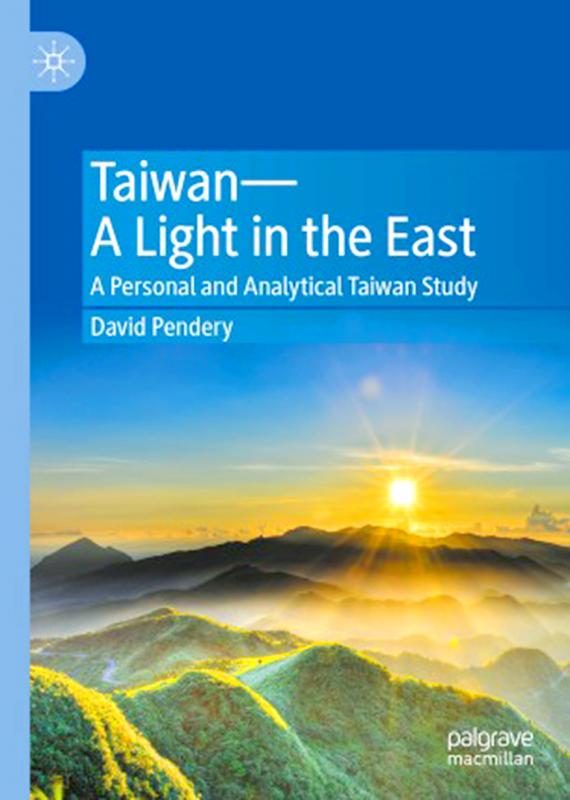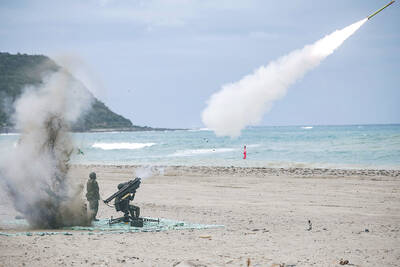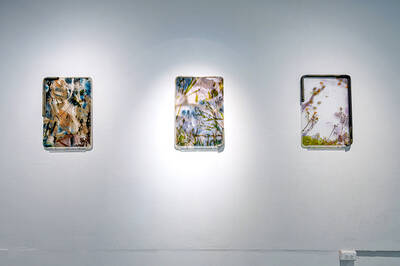In Taiwan — A Light in the East David Pendery aims to create “a systematic, relevant and in essence scholarly (if somewhat easygoing and personal) study of important issues and topics in Taiwan.”
In my review of an earlier Pendery book, Something Super (the Taipei Times, April 2, 2013), I said that the book had two heroes, Taiwan and the author himself. This time the emphasis is firmly on Taiwan. Pendery is very interested in politics, though admitting his “Chinese skills are not advanced enough that I can read political news in every newspaper and understand every statement that politicians make.”
He begins with the hypothesis that the entire population of the innumerable Pacific islands originated from Taiwanese aborigines migrating southwards. He goes on to make a case for the modern Taiwanese too being great migrators, what with students going to study abroad and 196,691 Taiwanese living in the US, according to the 2010 census, plus many more of Taiwanese descent.

Pendery then goes on to touch on the Dutch, Spanish and (far more long-lived) Japanese arrivals, though arguing that these foreign presences were not the cause of Taiwan’s modern internationalism, but rather the adventurous and out-going mind-frame of the Taiwanese people themselves.
“Taiwan is a prosperous, generous, healthy and dynamic country that seems to be enjoying the best fruits of its political choices,” Pendery writes at the end of a consideration of Francis Fukuyama’s 1992 book The End of History and the Last Man, which argued that the spread of liberal democracy and free-market capitalism may be the end-point of humanity’s political evolution. How remote this now seems!
But all this is only by way of a general introduction, and Pendery proceeds to write at great length on the issue of Taiwan’s diplomatic status (what if one day its diplomatic allies are reduced to zero?), President Trump’s relations with Chinese President Xi Jinping (習近平), Jared Daimond’s 2019 book Upheaval (which argues that individuals may learn from disasters but nations rarely do) and even Taiwan seen as a “Switzerland of the East” — Taiwan’s and Switzerland’s GDPs are almost equal according to the International Monetary Fund, even though Taiwan has a much larger population.
The author concludes this long chapter by considering Taiwan’s students — not necessarily the world’s happiest, but certainly among the world’s best catered-for.
It should be noted that in this book Pendery re-prints many of his pieces previously published as newspaper articles, mostly by the Taipei Times.
Pendery is a sober and trustworthy commentator on current affairs in Taiwan. He may not be a great stylist or a charmer, but he is reliable, and in the final analysis that’s what really matters. Balance is his forte even on the most contentious issues: “On the one hand this, but also on the other hand that.” This is Pendery’s signature tune. In other words, he is never partisan.
In considering the character of the Taiwanese, Pendery makes much of the phrase “a city on a hill,” something that citizens of other Asian nations look to for inspiration. The Taiwanese share essential qualities with the Americans, he says — and it’s impossible not to feel the shame that Pendery, as a loyal American, must be feeling following the recent events in Washington DC. Even so, he gets something of a personal shock when he finds he’s unable to have dual-nationality Taiwanese citizenship, something that very few have managed to obtain, though this is gradually changing.
In other words, Pendery considers Taiwan as a “transnational” state, one influenced by movements and ideologies originating from outside its borders. He cites Taiwan’s early democracy movements, its Wild Lily and Wild Strawberry movements, its activity on LGBT rights and its Sunflower protests. Education contributes here, he says, with up to 10 percent (over 100,000) of students coming from abroad.
On the other hand, the “Taiwanese aesthetic” derives from the ancient Chinese one. These two tendencies can conflict — Confucianism is no friend of feminism, for instance, as Pendery elsewhere observes. The book here reproduces a selection of pictorial items, artistic and social, that illustrate this thesis, with the comment that much more of the old traditions can be seen in Taipei’s National Palace Museum.
As for the future, Pendery admits to being a rare enthusiast for the idea of an “Asian Union” (on the lines of the European Union). The cultural variety within the region makes this unlikely, he confesses. But in general he’s optimistic about the future, pointing to health care (long a famous Taiwanese strength) and the fact that many Taiwanese cities can nowadays be called “smart.”
“To be sure Taiwan is a city-lover’s paradise, and municipalities north to south are advancing rapidly,” he writes.
He then looks at Hong Kong, where protesters have sometimes voiced the desire to re-locate in Taiwan (a move Beijing has declared to be illegal). President Tsai Ing-wen (蔡英文) has sounded sympathetic, but Pendery feels that Hong Kong’s citizens cannot expect ever to be totally independent from China.
In conclusion, Pendery sees Taiwan as a “strong-weak” state, weak in its lack of extensive diplomatic recognition, or recognition by the UN, and strong in its character and values. It was afforded a score or 93 out of 100 by Freedom House in 2019.
In a postscript on COVID-19, Pendery rightly praises Taiwan’s response (one of the most notable world-wide) while criticizing the WHO for its continuing refusal to admit Taiwan.
Pendery ends on a personal note, saying that he has been enormously happy here, and adding this to the manifold virtues of the nation discussed above.
Taiwan — a Light in the East, then, is an excellent book, well-informed, balanced and very clearly written. We must in addition congratulate Pendery on having graduated from Something Super’s publication by Xlibris, Amazon’s self-publishing format, to appearing this time from the prestigious international Palgrave Macmillan publishing house. The Kindle price on Amazon.com of $79.99 seems very expensive, however. Is this part of a general drift upwards in price for academic books?

In late October of 1873 the government of Japan decided against sending a military expedition to Korea to force that nation to open trade relations. Across the government supporters of the expedition resigned immediately. The spectacle of revolt by disaffected samurai began to loom over Japanese politics. In January of 1874 disaffected samurai attacked a senior minister in Tokyo. A month later, a group of pro-Korea expedition and anti-foreign elements from Saga prefecture in Kyushu revolted, driven in part by high food prices stemming from poor harvests. Their leader, according to Edward Drea’s classic Japan’s Imperial Army, was a samurai

Located down a sideroad in old Wanhua District (萬華區), Waley Art (水谷藝術) has an established reputation for curating some of the more provocative indie art exhibitions in Taipei. And this month is no exception. Beyond the innocuous facade of a shophouse, the full three stories of the gallery space (including the basement) have been taken over by photographs, installation videos and abstract images courtesy of two creatives who hail from the opposite ends of the earth, Taiwan’s Hsu Yi-ting (許懿婷) and Germany’s Benjamin Janzen. “In 2019, I had an art residency in Europe,” Hsu says. “I met Benjamin in the lobby

April 22 to April 28 The true identity of the mastermind behind the Demon Gang (魔鬼黨) was undoubtedly on the minds of countless schoolchildren in late 1958. In the days leading up to the big reveal, more than 10,000 guesses were sent to Ta Hwa Publishing Co (大華文化社) for a chance to win prizes. The smash success of the comic series Great Battle Against the Demon Gang (大戰魔鬼黨) came as a surprise to author Yeh Hung-chia (葉宏甲), who had long given up on his dream after being jailed for 10 months in 1947 over political cartoons. Protagonist

A fossil jawbone found by a British girl and her father on a beach in Somerset, England belongs to a gigantic marine reptile dating to 202 million years ago that appears to have been among the largest animals ever on Earth. Researchers said on Wednesday the bone, called a surangular, was from a type of ocean-going reptile called an ichthyosaur. Based on its dimensions compared to the same bone in closely related ichthyosaurs, the researchers estimated that the Triassic Period creature, which they named Ichthyotitan severnensis, was between 22-26 meters long. That would make it perhaps the largest-known marine reptile and would